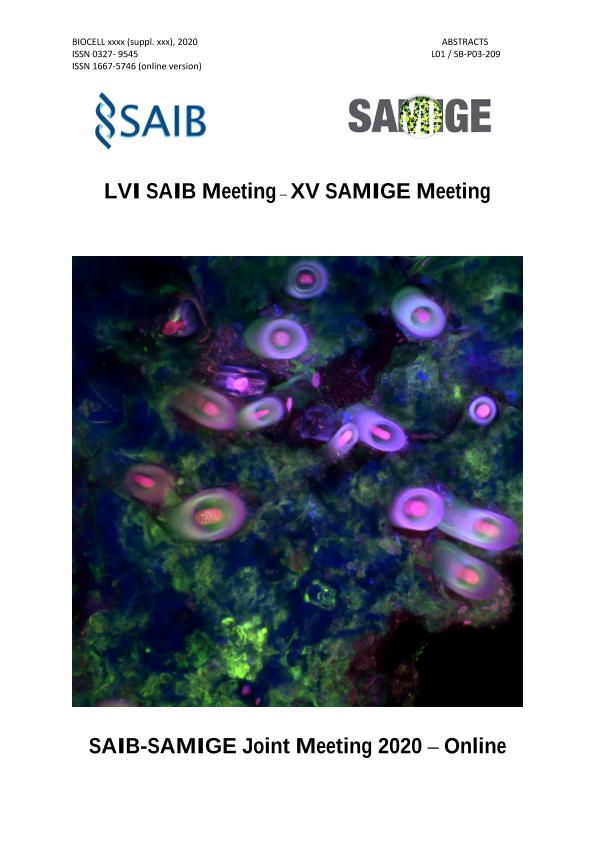Mostrar el registro sencillo del ítem
dc.contributor.author
Guerrero, Leandro Demián

dc.contributor.author
Orellana, Esteban

dc.contributor.author
Erijman, Leonardo

dc.date.available
2024-04-25T10:04:22Z
dc.date.issued
2020
dc.identifier.citation
In-depth bioinformatic crispr reconstruction from metagenomic data disclose phage-host evolution in complex environments; LVI Annual Meeting Argentine Society for Biochemistry and Molecular Biology; XV Annual Meeting Argentinean Society for General Microbiology; Ciudad Autónoma de Buenos Aires; Argentina; 2020; 1-2
dc.identifier.issn
0327-9545
dc.identifier.uri
http://hdl.handle.net/11336/234000
dc.description.abstract
Bacteriophages are highly abundant and ubiquitous in almost any habitat, where they play a critical role in shaping the microbiomes by infecting bacteria and archaea which carry out important processes to the environment. Lab-scale studies revealed that bacterial hosts respond to phage attacks by using a number of mechanisms that allow them to evade phage predation. In turn, genome rearrangements, mutations, and antibacterial defense systems allow phages to overcome these barriers, leading to an evolutionary arms race. However, laboratory settings do not necessarily reflect the more complex interactions that bacteria and phages experience in natural ecosystems. Metagenomics may complement this gap in information, but unfortunately, universal phylogenetic markers, such as the 16S rRNA gene of prokaryotes, are not present in phages. Therefore, investigating the diversity of phage communities and prediction of phage-host relationships is not straightforward. Taking advantage of the CRISPR (clustered regularly interspaced short palindromic repeats) system, which is present in most archaea and nearly 40% of bacteria, we developed a bioinformatic pipeline to provide a comprehensive picture of phage-host coevolution in naturally evolving populations within a complex environment from metagenomic data. The CRISPR-Cas systems are composed by Cas enzymes and an array of short DNA sequences, called spacers, separated by a repetitive sequence. Spacers are incorporated into CRISPR during unsuccessful phage attacks and it acts as an immune system, protecting the cell against future infections of the same phage. At the same time, it keeps a chronological register of previous attacks. In this approach, reads containing repetitive CRISPR sequences from multiple samples were used to reconstruct all the detectable variants of each particular CRISPR array. This resulted in a network of all possible spacers (nodes) connected by repeats (edges), which represent the spatio-temporal universe of CRISPR diversity. This network thus could be used to reconstruct the events of phage infections and identified the rise of new host populations. Phages were matched to their specific bacterial host by searching the corresponding protospacers within the metagenome and their genomes were reconstructed. This methodology was applied to predict phage-Gordonia associations and to assemble bacterial and phage variants in an environmental biotechnology system. By looking closely at single nucleotide variants and resolving CRISPR spacers that were present even at low abundance across a temporal series, we gained insight into the complexity of virus-host interaction at the population level in a real-world setting.
dc.format
application/pdf
dc.language.iso
eng
dc.publisher
Tech Science Press

dc.rights
info:eu-repo/semantics/openAccess
dc.rights.uri
https://creativecommons.org/licenses/by-nc-sa/2.5/ar/
dc.subject
CRISPR
dc.subject
METAGENOMIC
dc.subject
BACTERIOPHAGES
dc.subject.classification
Biología Celular, Microbiología

dc.subject.classification
Ciencias Biológicas

dc.subject.classification
CIENCIAS NATURALES Y EXACTAS

dc.title
In-depth bioinformatic crispr reconstruction from metagenomic data disclose phage-host evolution in complex environments
dc.type
info:eu-repo/semantics/publishedVersion
dc.type
info:eu-repo/semantics/conferenceObject
dc.type
info:ar-repo/semantics/documento de conferencia
dc.date.updated
2024-02-22T14:11:18Z
dc.identifier.eissn
1667-5746
dc.journal.volume
XXXX
dc.journal.number
Suppl. XXX
dc.journal.pagination
1-2
dc.journal.pais
Argentina

dc.journal.ciudad
Mendoza
dc.description.fil
Fil: Guerrero, Leandro Demián. Consejo Nacional de Investigaciones Científicas y Técnicas. Instituto de Investigaciones en Ingeniería Genética y Biología Molecular "Dr. Héctor N. Torres"; Argentina
dc.description.fil
Fil: Orellana, Esteban. Consejo Nacional de Investigaciones Científicas y Técnicas. Instituto de Investigaciones en Ingeniería Genética y Biología Molecular "Dr. Héctor N. Torres"; Argentina
dc.description.fil
Fil: Erijman, Leonardo. Consejo Nacional de Investigaciones Científicas y Técnicas. Instituto de Investigaciones en Ingeniería Genética y Biología Molecular "Dr. Héctor N. Torres"; Argentina
dc.relation.alternativeid
info:eu-repo/semantics/altIdentifier/url/https://www.saib.org.ar/sites/default/files/BIOCELL-SAIB-2020-version-final.pdf
dc.conicet.rol
Autor

dc.conicet.rol
Autor

dc.conicet.rol
Autor

dc.coverage
Nacional
dc.type.subtype
Reunión
dc.description.nombreEvento
LVI Annual Meeting Argentine Society for Biochemistry and Molecular Biology; XV Annual Meeting Argentinean Society for General Microbiology
dc.date.evento
2020-11-02
dc.description.ciudadEvento
Ciudad Autónoma de Buenos Aires
dc.description.paisEvento
Argentina

dc.type.publicacion
Journal
dc.description.institucionOrganizadora
Sociedad Argentina de Investigación en Bioquímica y Biología Molecular
dc.description.institucionOrganizadora
Sociedad Argentina de Microbiología General
dc.source.revista
Biocell

dc.date.eventoHasta
2020-11-05
dc.type
Reunión
Archivos asociados
